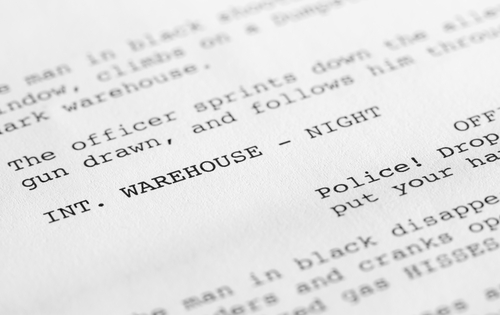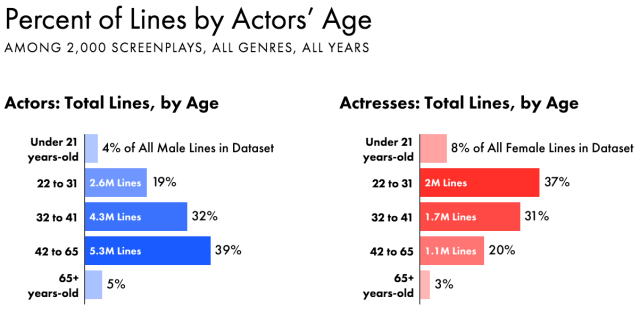Largest Script Analysis Ever Breaks Down Over 2,000 Scripts by Gender and Age
Not good.


The fine folks over at Polygraph shared an excellent analysis of over 2,000 screenplays, breaking them down by gender and age. Right up front: the results aren’t too great. Though, let’s be honest, that’s kind of what you were expecting anyway, wasn’t it? According to their analysis of 30 Disney films, 22 of those films have a male majority of dialogue, with the “worst offender” being The Jungle Book at over 98% male lines. Five of those movies have a fair gender balance within a tolerance of 10% difference between male and female lines, and only four movies out of the 30 have a majority of female lines. Interestingly enough, two of those four movies are Sleeping Beauty and its modern “spin-off,” Maleficent.
Even movies that are ostensibly female-focused like Mulan ended up having a majority of male lines. One could make the argument that since Mulan is the only female character for the majority of the film, it might make sense, but the interesting thing is that her co-star, Mushu, had 50% more lines than she did. As well, the folks behind the analysis acknowledge that it’s not exactly perfect; these are statistics based on analysis of the screenplay, which doesn’t necessarily reflect the final product. Thus, there’s perhaps a bit of a margin of error involved.
The overall analysis turned up some not-so-surprising news: in only 22% of the thousands of films they analyzed, actresses had the most number of lines. Moreover, looking at the roles themselves, there are a scant few films where women make up the majority of the top three roles in a film. From the website:
Women are more likely to be in the second place for most number of lines, which occurs in 34% of films. The most abysmal stat is when women occupy at least 2 of the top 3 roles in a film, which occurs in 18% of our films. That same scenario for men occurs in about 82% of films.
Where the study gets especially interesting is when they analyze roles and lines by age. As we’ve just established, Hollywood has a significant problem with gender balance, but we’re also aware that Hollywood has an even more tremendous problem with ageism, which can affect both male and female roles, yet is often disproportionately used to discriminate within female roles. Their findings were quite shocking.

They write:
The number of lines, by age-range, is completely opposite for women versus men. Lines available to women who are over 40 years-old decrease substantially. For men, it’s the exact opposite: there’s more roles available to older actors.
Kind of sobering, isn’t it? The Polygraph website is absolutely worth a visit, if only because many of the infographics are interactive. You can search for statistics on a film of your choice to see how it breaks down along these lines. As the writers behind the study are happy to point out, thanks to this analysis, we’re now armed with statistics to point out the inequalities between these two genders in film. That being said, I would love to see a study that digs a little deeper and looks at the intersection between gender and race. As we know, according to a study carried out by USC’s school for communication and journalism, “No platform presents a profile of race/ethnicity that matches proportional representation in the U.S. Over 50% of stories featured no Asian speaking characters, and 22% featured no Black or African American characters. The complete absence of individuals from these backgrounds is a symptom of a diversity strategy that relies on tokenistic inclusion rather than integration.”
Hollywood has some work to do. At least these folks are working to make sure that it’s all cut out for them.
(image via Shutterstock/Mark Poprocki)
—The Mary Sue has a strict comment policy that forbids, but is not limited to, personal insults toward anyone, hate speech, and trolling.—
Follow The Mary Sue on Twitter, Facebook, Tumblr, Pinterest, & Google+.
Have a tip we should know? tips@themarysue.com